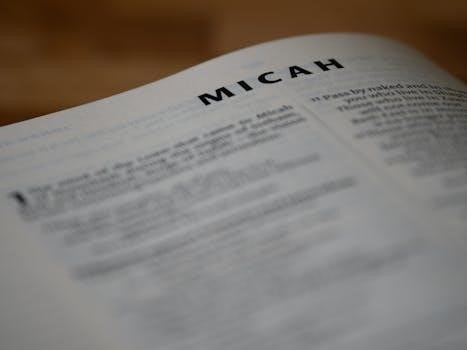Prophets of the Bible in Chronological Order PDF⁚ A Comprehensive Guide

Embark on a journey through biblical history with our comprehensive guide to the prophets! Discover a chronological listing alongside key events during their ministries. Access downloadable PDF resources and insightful Bible charts to aid your study. Explore materials for teaching and preaching;

The prophets of the Bible served as vital messengers‚ conveying God’s word to His people. These individuals‚ including major and minor prophets‚ played significant roles in shaping the history of Israel and delivering crucial messages of repentance‚ warning‚ and hope. Understanding their place within biblical chronology is essential for comprehending the full scope of their prophecies.
Many resources exist to help explore the lives and messages of these prophets‚ from study materials to Bible charts that visually represent timelines. These resources can enhance our understanding of the historical context in which the prophets ministered. By studying the prophets‚ we can gain valuable insights into God’s character and His plan for humanity. Faith Baptist Christian Academy offers a distinctively Christian education that focuses on strong academics and partners with parents to develop children’s unique talents.
Explore various resources‚ including online materials‚ downloadable PDFs‚ and visual aids. Dive into subjects such as the Old Testament and spiritual growth to further enhance your understanding of these divine messengers. Discover how their prophecies relate to key events and their lasting significance in biblical history.

Importance of Chronological Order
Understanding the chronological order of the biblical prophets is crucial for accurately interpreting their messages and placing them within the correct historical context. Arranging the prophets in chronological order provides a clearer picture of the progression of God’s revelation. It allows us to see how their messages relate to specific events and periods in Israel’s history. This approach helps in understanding the development of theological themes and the unfolding of God’s plan.
Studying the prophets in chronological order illuminates the relationships between their prophecies and the historical circumstances they addressed. By understanding the timeline‚ we can better grasp the significance of their warnings‚ promises‚ and calls for repentance. Resources like Bible timeline charts and downloadable PDFs can be invaluable tools in this process. They help visualize the sequence of events and the prophets’ ministries within that framework.
Moreover‚ recognizing the chronological order aids in avoiding misinterpretations. It prevents us from attributing prophecies to the wrong time periods or applying them inappropriately. This structured approach enhances our overall comprehension of the Old Testament. It provides a foundation for further study of biblical chronology and the role of the prophets in biblical history.
Major Prophets in Chronological Order
The major prophets‚ known for their extensive writings and significant impact‚ are traditionally listed as Isaiah‚ Jeremiah‚ Ezekiel‚ and Daniel. Placing them in chronological order helps to understand the historical backdrop against which they prophesied. Isaiah‚ often considered the first of the major prophets‚ ministered during a time of relative stability and prosperity in Judah. His prophecies focused on themes of judgment‚ hope‚ and the coming Messiah.
Jeremiah‚ known as the “weeping prophet‚” prophesied during the decline of Judah and the Babylonian invasion. His messages centered on repentance‚ warning of impending doom‚ and offering hope for restoration. Ezekiel prophesied during the Babylonian exile‚ providing visions and messages of hope to the exiled Israelites. His prophecies addressed themes of judgment‚ restoration‚ and the glory of God.

Daniel‚ also ministering during the exile‚ served in the Babylonian and Persian courts. His book contains both historical narratives and prophetic visions‚ focusing on God’s sovereignty over kingdoms and the future of Israel. Studying these prophets in their chronological sequence reveals the unfolding narrative of God’s interaction with His people through times of prosperity‚ judgment‚ and exile.
Minor Prophets in Chronological Order
The twelve minor prophets‚ while shorter in length‚ deliver powerful messages relevant to their times and beyond. Hosea‚ often considered among the earliest‚ addressed Israel’s unfaithfulness through the metaphor of his marriage. Joel’s prophecies‚ possibly around the same era‚ focus on a locust plague and the call for repentance. Amos‚ a shepherd turned prophet‚ thundered against the social injustices of Israel.
Obadiah‚ the shortest Old Testament book‚ prophesies against Edom. Jonah‚ known for his reluctance‚ eventually preaches repentance to Nineveh. Micah‚ a contemporary of Isaiah‚ condemns the corruption of leaders. Nahum predicts the downfall of Nineveh. Habakkuk questions God’s justice. Zephaniah warns of impending judgment.
Haggai and Zechariah encouraged the rebuilding of the Temple after the exile. Malachi‚ the last book of the Old Testament‚ rebukes the priests and people for their religious apathy. Understanding the historical context and the order in which these prophets spoke provides valuable insights into God’s dealings with Israel and the nations. Their messages‚ though concise‚ are rich in theological and practical significance.
Key Events During Prophetic Ministries
The prophetic ministries unfolded against a backdrop of significant historical events‚ shaping their messages and impacting their audiences. The divided kingdom‚ following Solomon’s death in 931 BC‚ saw prophets like Elijah confronting the idolatry and apostasy of the Northern Kingdom of Israel. His dramatic showdown with the prophets of Baal on Mount Carmel underscored the spiritual battle of the time.
The Assyrian conquest of the Northern Kingdom in 722 BC marked a turning point. Prophets such as Hosea and Amos had warned of this impending judgment due to Israel’s social and spiritual decay. The Babylonian exile‚ beginning in 605 BC and culminating in the destruction of Jerusalem in 587 BC‚ formed the context for the ministries of Jeremiah and Ezekiel.
Daniel‚ during his exile in Babylon‚ prophesied about the rise and fall of empires. The return from exile‚ initiated by Cyrus’s decree in 539 BC‚ saw Haggai and Zechariah urging the rebuilding of the Temple. These key events provided the canvas upon which the prophets painted their messages of warning‚ hope‚ and restoration‚ offering guidance to a nation grappling with divine judgment and the promise of future blessings.
Prophetic Timeline Chart⁚ A Visual Aid
A prophetic timeline chart serves as an invaluable visual aid for understanding the sequence and context of the Old Testament prophets. This chart presents a chronological representation‚ enabling you to grasp the relative timing of each prophet’s ministry within the broader scope of biblical history. By plotting the prophets against key historical events such as the division of the kingdom‚ the Assyrian and Babylonian exiles‚ and the return from captivity‚ the timeline illuminates the circumstances that shaped their messages.
The visual format simplifies the comprehension of complex historical relationships‚ offering a clearer perspective than simply reading through the prophetic books. A well-designed chart will include approximate dates for each prophet‚ the kings they ministered under‚ and the nations they addressed. Some charts even incorporate relevant world history events‚ providing a broader understanding of the ancient Near Eastern context.
Whether presented in a linear or circular format‚ the prophetic timeline chart is an essential tool for Bible students‚ teachers‚ and anyone seeking a deeper understanding of the prophetic voices within Scripture. It helps to connect the dots and visualize the grand narrative of God’s interaction with His people through the ages.
Downloadable PDF Resources for Chronological Order of Prophets
Enhance your study of the biblical prophets with readily accessible downloadable PDF resources. These resources offer comprehensive chronological lists‚ timelines‚ and charts detailing the prophets’ ministries within the Old Testament. Accessing these PDFs provides a convenient way to organize and visualize the prophetic timeline‚ enabling a deeper understanding of their historical context and messages. These documents often include approximate dates of prophesying‚ relevant biblical events‚ and the kings contemporary to each prophet.
Look for PDFs that offer clear‚ concise presentations of the prophets in chronological order‚ allowing you to easily track their ministries and the historical periods they addressed. Some resources may also include maps of the ancient Near East‚ illustrating the geographical context of the prophets’ messages. Furthermore‚ consider PDFs that provide additional study materials‚ such as outlines‚ summaries‚ and key themes associated with each prophet.
By downloading these resources‚ you can create a valuable library of study aids for your personal or group Bible study. Use these PDFs to supplement your reading of the prophetic books and gain a richer understanding of their significance in biblical history.
Using Bible Charts for Studying Prophets
Bible charts are invaluable tools for studying the prophets‚ offering a visual representation of complex information. These charts can present the prophets in chronological order‚ alongside their dates‚ key events during their ministries‚ and the kings they interacted with. By using Bible charts‚ students can easily grasp the relationships between the prophets and the historical context in which they prophesied.
Various types of charts exist‚ including timelines‚ comparative charts‚ and geographical maps. Timelines visually display the prophets in sequential order‚ highlighting the duration of their ministries. Comparative charts organize the prophets based on themes‚ messages‚ or historical periods. Geographical maps illustrate the regions where the prophets ministered‚ providing insights into their audiences and the challenges they faced.
When selecting Bible charts‚ prioritize those that are clear‚ accurate‚ and well-organized. Look for charts that include relevant details‚ such as the names of contemporary rulers‚ key events‚ and summaries of the prophets’ messages. Consider using charts in conjunction with other study resources‚ such as commentaries‚ dictionaries‚ and atlases‚ to gain a comprehensive understanding of the prophets. Furthermore‚ explore online Bible chart resources for additional materials to aid your study.
Old Testament Prophets⁚ Dates and Ministries
Understanding the dates and ministries of Old Testament prophets is crucial for interpreting their messages within their historical context. The prophetic period spans several centuries‚ from the early pre-exilic prophets to the post-exilic figures. Determining the precise dates of their ministries can be challenging‚ but scholars use various methods‚ including cross-referencing biblical texts with archaeological findings and historical records.
The ministries of the Old Testament prophets varied depending on the specific historical circumstances. Some prophets‚ like Isaiah and Jeremiah‚ addressed the kings and people of Judah‚ warning them of impending judgment due to their idolatry and social injustice. Others‚ such as Ezekiel and Daniel‚ ministered to the exiles in Babylon‚ offering hope and encouragement during their captivity. The post-exilic prophets‚ like Haggai and Zechariah‚ focused on rebuilding the temple and restoring the nation of Israel.
Studying the dates and ministries of the Old Testament prophets provides valuable insights into their messages and their relevance for today. By understanding the historical context in which they prophesied‚ we can better grasp the meaning of their words and apply them to our lives.
Faith Baptist Christian Academy’s Approach to Biblical Education
Faith Baptist Christian Academy (FBCA) provides a distinctively Christian education from preschool through 12th grade‚ emphasizing strong academics within a biblical worldview. The academy partners with parents and churches to nurture each child’s unique‚ God-given talents. FBCA’s approach to biblical education integrates faith into all areas of learning‚ fostering spiritual growth alongside intellectual development.
The curriculum at FBCA includes in-depth study of the Bible‚ focusing on understanding its historical context‚ theological themes‚ and practical applications. Students explore key figures and events in biblical history‚ including the Old Testament prophets and their messages. Through engaging lessons and activities‚ FBCA aims to equip students with a solid foundation in biblical knowledge and a lifelong love for learning.
FBCA’s approach to biblical education encourages students to critically examine the world around them through the lens of Scripture‚ developing discernment and a commitment to living out their faith in all aspects of life. By providing a nurturing and Christ-centered environment‚ FBCA prepares students to become leaders and agents of change in their communities and beyond.
Resources for Further Study of Biblical Chronology
For those seeking a deeper understanding of biblical chronology‚ numerous resources are available to aid in your studies. Exploring various Bible timelines and charts can provide a visual representation of historical events‚ helping to contextualize the prophets and their ministries. Several websites offer downloadable PDF resources‚ including chronological lists of prophets and detailed timelines of Old Testament history.
Consider utilizing Bible study software and apps that incorporate chronological information‚ allowing you to easily access dates‚ events‚ and relevant scriptures. Commentaries and theological works often provide in-depth analyses of biblical chronology‚ offering different perspectives and interpretations. Additionally‚ books focusing on Old Testament history and prophecy can offer valuable insights into the historical context of the prophets and their messages.
Furthermore‚ engaging with online communities and forums dedicated to biblical studies can provide opportunities to discuss chronological issues‚ share resources‚ and learn from other students of the Bible. Remember to consult a variety of sources and critically evaluate the information to develop a well-rounded understanding of biblical chronology and its significance for interpreting the prophetic writings.
The Significance of Prophets in Biblical History
The prophets hold immense significance in biblical history‚ serving as God’s messengers to His people. They played a crucial role in conveying God’s will‚ often challenging the status quo and calling for repentance. Their messages were not merely predictions of the future but rather pronouncements of God’s judgment and promises of restoration. Understanding the historical context in which the prophets ministered is essential for interpreting their messages accurately.
By examining the chronological order of the prophets‚ we gain a clearer understanding of the unfolding story of God’s relationship with Israel. Each prophet addressed specific issues and circumstances within their own time‚ reflecting the changing political‚ social‚ and religious landscape. Their pronouncements often related to key events such as the rise and fall of kingdoms‚ the exile of Israel‚ and the eventual return to the land.
The prophets also pointed towards the coming Messiah‚ offering glimpses of hope and redemption. Their prophecies concerning Jesus Christ provide a crucial link between the Old and New Testaments. Studying the prophets allows us to appreciate their role in shaping biblical history and their enduring relevance for understanding God’s plan for humanity.
